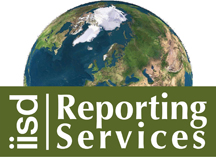News * Abou us * the ENB team * DONATE * Activities * Search * IISD RS home * IISD.org * RSS * What is RSS? * Links |
|
MEA Bulletin Guest Article (b)
Thursday,
20 December 2007 UNDP MDG Carbon Facility: Leveraging Carbon Finance for Sustainable Development By Yannick Glemarec, UN Development Programme/Global Environment Facility Executive Coordinator and UNDP Environmental Finance Manager Climate change threatens to seriously undermine efforts to eliminate poverty and reach the Millennium Development Goals (MDGs), particularly in the least developed countries. At greatest risk are the rural poor, who depend on the natural environment for their livelihoods. World temperatures have increased by around 0.7 C since the advent of the industrial era. The 2007/2008 Human Development Report on Fighting Climate Change launched by UNDP this November highlights that keeping 21st Century global temperature increases within a 2 C threshold above pre-industrial levels will require cuts in emissions of greenhouse gases by at least 50% relative to 1990 levels. The IEA (2006) estimates that the investment required in energy infrastructure in developing countries to meet growing energy needs will exceed $ 300 billion/year over the period 2001-2030. ODA, at present, provides approximately $7 billion per year for energy-related activities, and is only a small percentage of what is required. Thus, the double challenge for energy and climate change policies today is to find ways to attract enough direct investment to meet the growing energy supply infrastructure needs of low income countries to sustain their economic development and to drive these direct investments towards lower carbon technologies, to avoid dangerous climate change. Clearly, major new investments and innovative financing mechanisms are needed. The good news is that the new carbon market mechanisms that have emerged under the Kyoto Protocol, notably the Clean Development Mechanism (CDM) and the Joint Implementation (JI), have the potential to substantially augment financial resources available to developing countries and Economies in Transition for clean energy development and sustainable land management. In 2006, the value of the burgeoning CDM market was around $5 billion – up from zero in less than 5 years. According to a recent UNFCCC report, the CDM could leverage between $15 and $100 billion per year of additional resources to promote sustainable development in developing countries by 2030. Recognizing the role that carbon finance can play, a major focus of UNDP’s mitigation efforts is on increasing the ability of countries to access carbon markets in a manner that allows them to capitalize on the double dividend of climate mitigation along with socio-economic progress. To date, UNDP has implemented CDM/JI capacity development activities in more than 20 countries. Nonetheless, the number of countries accessing this expanding CDM/JI market in a significant way is small. Currently, just five countries are expected to generate over 80% of CDM credits by 2012. All too often, current market rules are also failing to attract direct investors into lower-carbon technologies and sustainable land use projects. Almost half of the anticipated CDM credits to 2012 will come from non-CO2 industrial gas emissions (such as HFC23 destruction and capture of N2O emissions), characterized by a high return on investment but limited human development benefits. What can UNDP do about it? UNDP considers climate change to hit at the very heart of its development mission. In tandem with other UN organizations, as well as the rest of the development and environmental community, UNDP is on the ground in developing countries, providing real solutions to this critical challenge of our time. UNDP’s approach for mitigating climate change is to enable developing countries to align their GHG reduction and human development efforts, and promote mitigation activities that do not slow down, but rather accelerate socio-economic progress. For example, a shift from fossil fuel based energy to renewable energy alternatives can produce development dividends in the form of reducing the energy bill of oil-importing countries, increasing energy security, providing increased access to energy for the rural poor, and reducing local environmental health impacts, among others. Building on its experience in market transformation for low carbon technologies as one of the three founding Implementing Agencies of the Global Environment Facility (GEF), UNDP has established the MDG Carbon Facility to help leverage the potentially significant benefits of carbon finance. Its core objectives are:
The MDG Carbon Facility forms part of UNDP’s comprehensive, three-step approach to capacity development in carbon finance. On a country-by-country basis, this approach commences with barrier removal to direct investment in lower carbon technologies, then addresses the establishment of efficient host-country procedures for CDM and JI, and finally culminates in the development of pioneer emission reduction projects by the Facility. Once a carbon market is firmly established, attracting private-sector investment and developing project technologies that deliver longer-term development benefits, the MDG Carbon Facility will exit that market, having accomplished its market transformation objectives.
How does the MDG Carbon Facility work?
The MDG Carbon Facility
represents an innovative public-private partnership
between UNDP and an international financial services
provider, Fortis Bank, offering prospective emission
reduction projects a comprehensive "one-stop-shop"
package of services. Under the terms of the partnership
UNDP will help developing countries conceive projects
intended to reduce emissions of greenhouse gases, and
will ensure that these projects meet the CDM’s and JI’s
agreed standards and deliver real, sustainable benefits
to the environment and broader human development. Fortis
will then purchase and re-sell the emissions offsets
generated by these projects. Proceeds from Fortis’
purchases will provide developing countries and
communities with a new flow of resources to finance much
needed investment and to promote development.
The MDG Carbon Facility capitalizes on UNDP’s specialized expertise and global reach, to combine them with Fortis’ resources and substantial carbon experience. UNDP’s collaboration with Fortis will encompass an initial pipeline of projects issuing emission offsets during the first Kyoto commitment period from 2008 to 2012. There is a lot more to say about the Facility. For further information about the Facility, I would like to invite you to visit our website at http://www.undp.org/mdgcarbonfacility/index.html |


